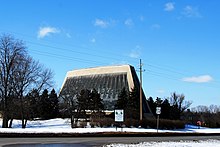Temple Beth El (Detroit, Michigan)
| Temple Beth-El | |
|---|---|

Current Temple Beth El, opened in 1973
|
|
| Basic information | |
| Location | 7400 Telegraph Road Bloomfield Township, Michigan |
| Affiliation | Reform Judaism |
| Country | United States of America |
| Status | Active |
| Website | http://www.tbeonline.org/ |
| Architectural description | |
| Architect(s) | Minoru Yamasaki |
| Architectural style | Modern |
| Completed | 1973 |
Temple Beth El, also known as Temple Beth-El, is a Reform synagogue currently located in Bloomfield Township, Michigan, United States. Beth El was founded in 1850 in the city of Detroit, and is the oldest Jewish congregation in Michigan.
In 1982, its two former buildings in Detroit, at 3424 and 8801 Woodward Avenue, were listed on the National Register of Historic Places.
In 1850, Sarah and Isaac Cozens arrived in Detroit and moved into a house near the corner of Congress and St. Antoine streets. At the time, there were only 60 Jews in Detroit (out of a population of over 21,000) and no synagogues. Sarah urged her co-religionists to establish a congregation, and on September 22, 1850, twelve Jewish families came together at the Cozens's home to found the "Beth El Society" (a Michigan Historical Marker now commemorates this site). The congregation engaged the services of Rabbi Samuel Marcus of New York.
Rabbi Marcus conducted services in the Orthodox mode, first in the Cozens's home and later in a room above a store on Jefferson Avenue. In 1851, the congregation legally incorporated, and adopted its first constitution the following year. In 1854, Rabbi Marcus died of cholera, and the congregation chose Rabbi Leibman Adler, the father of famed Chicago School architect, Danker Adler, as his successor.
In 1856, the congregation adopted a new set of by-laws including a number of innovations from the then-emerging Reform Judaism. Although the congregation was slowly growing, due in part to the influx of Jews to Detroit, some members of the congregation were unhappy with the reforms. In 1860, the new by-laws were debated and re-affirmed. However, the introduction of music into the worship service in 1861 caused a split, with 17 of the more Orthodox members of the congregation leaving to form Congregation Shaarey Zedek. The remaining congregants adopted another set of by-laws in 1862, introducing greater reforms.
...
Wikipedia
